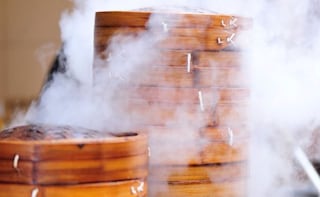Steamed food is often misconstrued to mean bland food, but the two don’t necessarily have to walk hand in hand. The process of steaming is probably one of the oldest in culinary books and a simple one to master. It is all about correct timing, as a few minutes difference could either make or break your dish.
Simply Delicious: Top 5 Idli RecipesLet Out the SteamSteaming is considered to be one of the most effective techniques to preserve the texture, flavour and nutrition of the ingredients. When we pressure cook or boil food, most of the vitamins and minerals are lost in the water. But the process of steaming uses only moist heat to cook the food. All the ingredients cook in their own juices thereby retaining all their nutrients.
Start Stocking: 6 Healthy Foods You're Probably Neglecting
Recipe by Seema ChandraDelicately steamed fish fillets, smeared in an aromatic Thai sauce made of lemongrass, kaffir lime leaves, galangal and red chillies.
Recipe by Divya BurmanA healthy twist to dumplings, the flour-based casing is replaced with cabbage leaves, and stuffed with spiced minced chicken.10 Best Dumpling Recipes
Recipe by Chef Vicky RatnaniSteamed yellow squash, zucchini, green beans and asparagus batons served in a pool of potato and leek sauce.
Recipe by Aditya Bal and DevanshiFresh tofu cubes are marinated in a Chinese spice mix an carefully steamed to make this hearty treat.
Recipe by Chef Joy BanerjeeFarm fresh potatoes smeared in a tantalising paste made of mustard, coconut and curd, and steamed. Comfort food at its best!
Simply Delicious: Top 5 Idli RecipesLet Out the SteamSteaming is considered to be one of the most effective techniques to preserve the texture, flavour and nutrition of the ingredients. When we pressure cook or boil food, most of the vitamins and minerals are lost in the water. But the process of steaming uses only moist heat to cook the food. All the ingredients cook in their own juices thereby retaining all their nutrients.
Advertisement
Advertisement
Advertisement
Start Stocking: 6 Healthy Foods You're Probably Neglecting
Advertisement
Recipe by Seema ChandraDelicately steamed fish fillets, smeared in an aromatic Thai sauce made of lemongrass, kaffir lime leaves, galangal and red chillies.
Recipe by Divya BurmanA healthy twist to dumplings, the flour-based casing is replaced with cabbage leaves, and stuffed with spiced minced chicken.10 Best Dumpling Recipes
Recipe by Chef Vicky RatnaniSteamed yellow squash, zucchini, green beans and asparagus batons served in a pool of potato and leek sauce.
Recipe by Aditya Bal and DevanshiFresh tofu cubes are marinated in a Chinese spice mix an carefully steamed to make this hearty treat.
Recipe by Chef Joy BanerjeeFarm fresh potatoes smeared in a tantalising paste made of mustard, coconut and curd, and steamed. Comfort food at its best!
For the latest food news, health tips and recipes, like us on Facebook or follow us on Twitter and YouTube.
Advertisement
